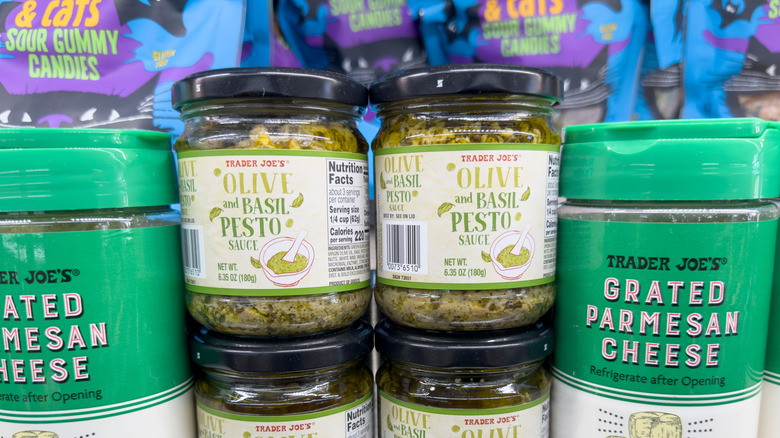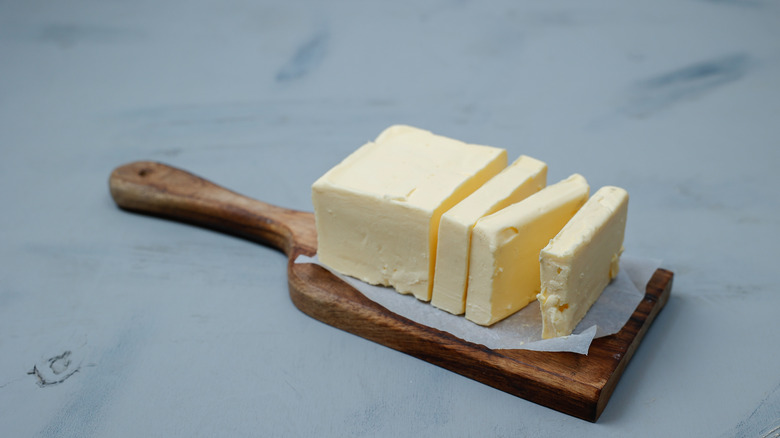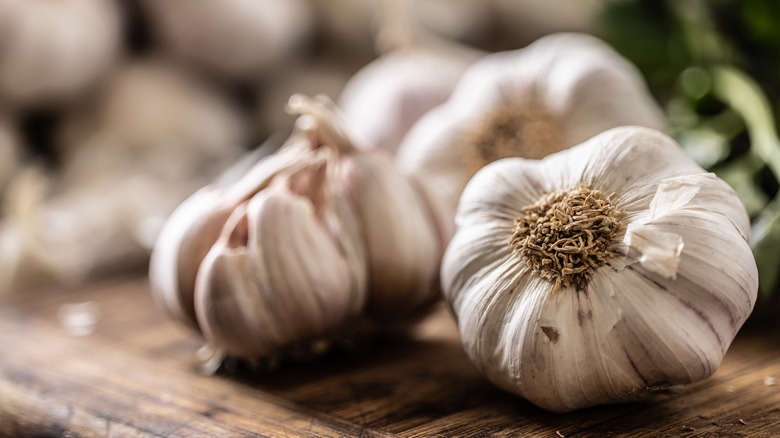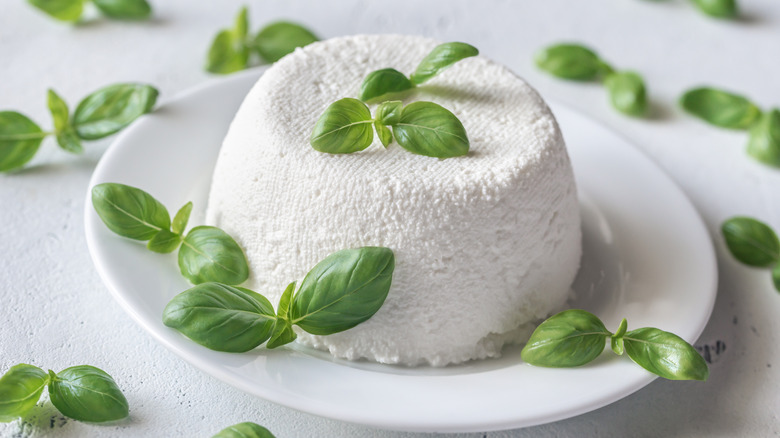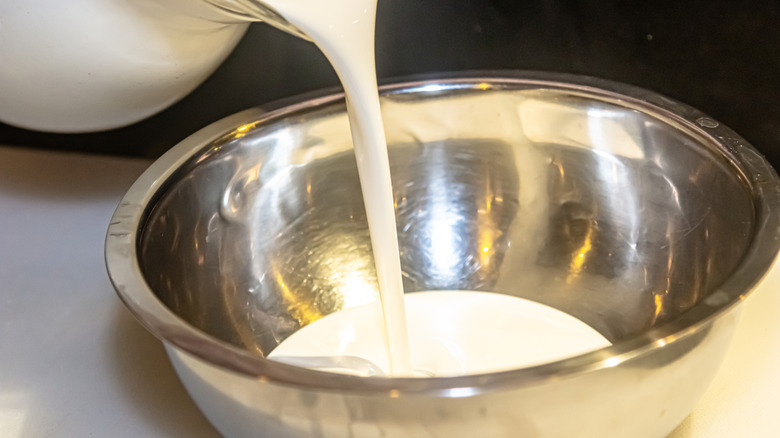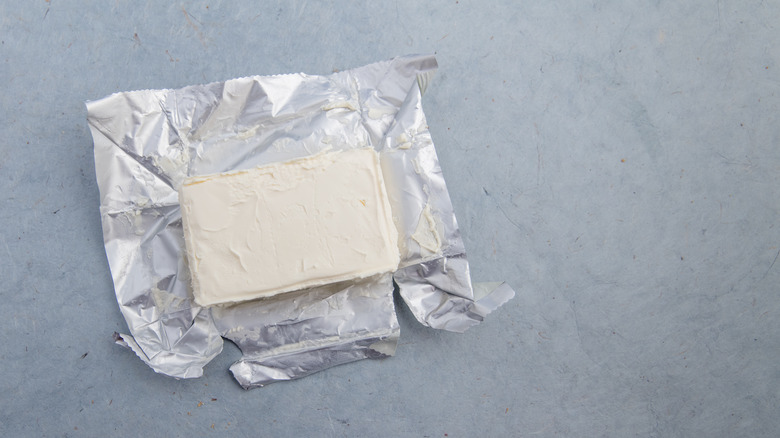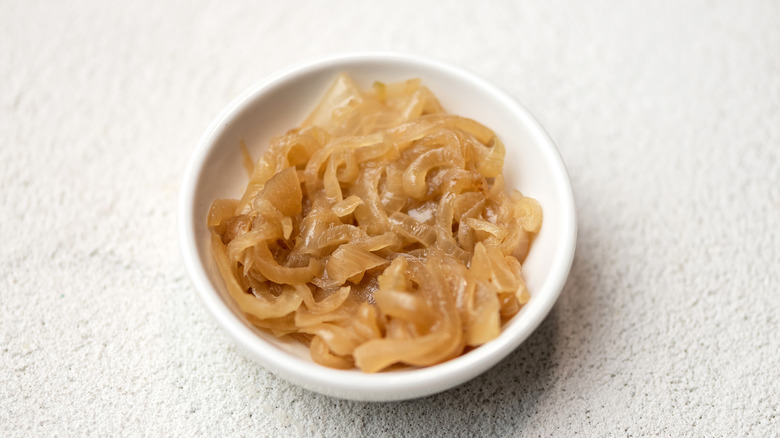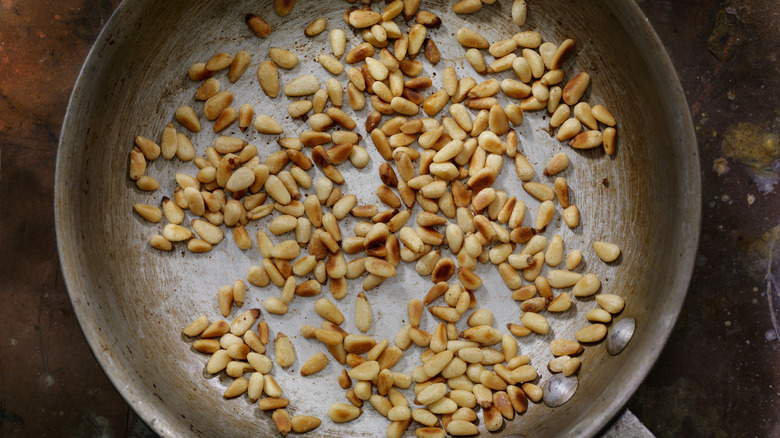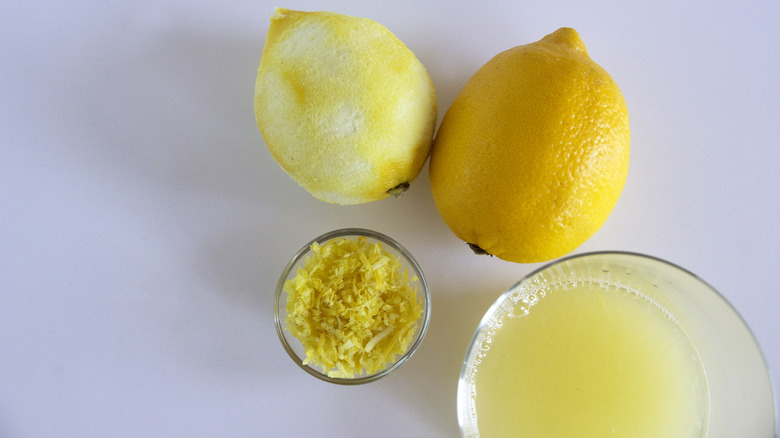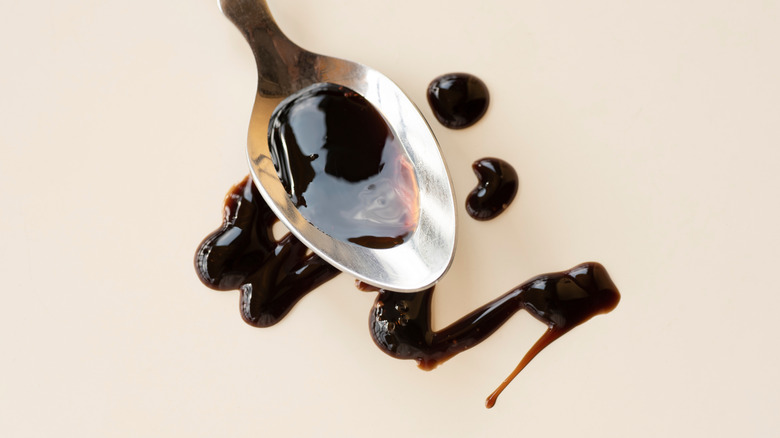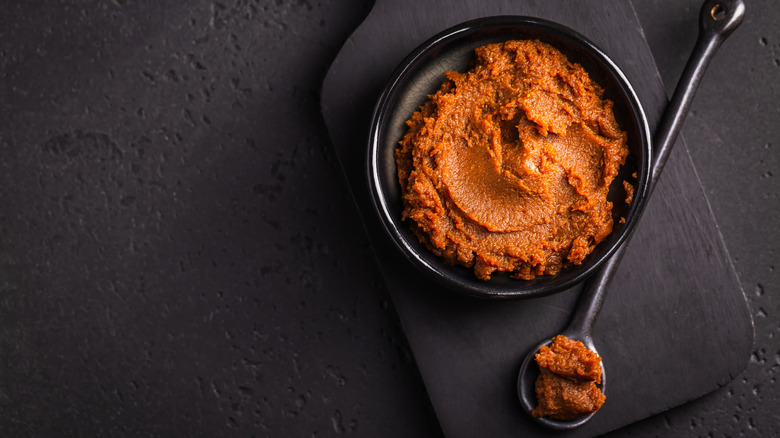13 Ways To Upgrade Store-Bought Pesto
Grabbing a jar of pesto from a supermarket is an easy way to liven up a meal, whether stirred through pasta, spread on sandwiches, or dolloped over salads. There are so many ways to use it to level up meals or add to recipes, so it's a great time saver — but the versions you can buy from shops aren't always great. That's why you might be looking for ways to upgrade store-bought pesto.
Sure, some jarred pestos are better than others, but none can reach the heights of a high-quality homemade offering. Still, that doesn't mean you have to settle for a subpar product. You can use ingredients — many of which you might already have in your fridge or pantry — to improve ready-made pesto. Whether you want to thin it out with more olive oil, make a creamy version, or dial the garlic up to 11, there are all kinds of options to make it more flavorful.
And you don't have to stick to just one of these methods, either. Once you've learned all these tasty ways to level-up your pesto, you can combine several of them for even better results. You might never make jarred options taste homemade, but you can get close and create some delicious concoctions while you're at it.
1. Add some high-quality extra-virgin olive oil
You can add more olive oil to store-bought pesto to make it taste even better. This is a particularly good move if the brand you've chosen is a bit too intense. Some jarred pestos are extremely salty and can actually be improved by being diluted a little — especially with a high-quality extra-virgin olive oil.
It's even more essential if the pesto you've chosen contains a neutral oil like canola or sunflower instead of olive oil. Or, even if it contains refined olive oil instead of extra-virgin. Great pesto needs the complex pepperiness of extra-virgin olive oil, so if there's none in your jar, you need to rectify that. Use your judgement and add a tablespoon or so at a time until the sauce is to your liking. This is also a great option if you're going to be drizzling it, as some store-bought pesto is quite thick.
Just be aware that not all extra-virgin olive oils are what they say they are. It can be tough even for experts to spot fake olive oil, but look for ones from small producers if possible. The type you'd find at a fancy deli rather than the cheapest supermarket bottle. Or, at the very least, choose an olive oil that you enjoy the taste of.
2. Mix in some softened butter
If you're looking for a creamier pesto, one option is to mix in some softened butter. It might seem like an odd choice to combine butter with a food like pesto. After all, isn't Italian food all about the olive oil? Well, you might be surprised to know that butter is a fairly common ingredient in many Italian dishes, especially in the cooler Northern region of the country. So there's nothing particularly strange about a pesto-butter combo.
Once you've mixed together room temperature butter and pesto, you effectively have a compound butter that you can use in many ways. It's great stirred into pasta, where the butter will melt and become extra creamy. You can also spread it in sandwiches, use it as a base for bruschetta or crostini, or use it to make a kind of herby garlic bread. Since pesto is already quite salty, it's best to opt for unsalted butter — but use the real stuff rather than margarine.
3. Use some more garlic
Pesto contains some garlic, but sometimes the store-bought versions go easy on it. After all, they have to appeal to as many people as possible, and some folks are easily overwhelmed by garlic. So, one way to add a bit more punch to your jarred sauce is to use extra garlic. If you cook regularly, you probably already have plenty of garlic at home, so it's an easy upgrade.
There are various ways that you can add more garlic to your pesto. The simplest is to finely mince a clove or grate it with a microplane grater and mix it in. An alternative is to blend a clove with some extra-virgin olive oil and stir it through. However, a strong raw garlic taste isn't for everyone. You can slightly mellow garlic by soaking it in lemon juice for a few minutes, so this is another option — plus you get the extra zinginess of lemon to further level up your dish.
However, some people might prefer to add cooked garlic. A quick and easy option is to sauté a couple of cloves of minced garlic — cooked stuff is less potent so you can use more. Alternatively, roast a full bulb of garlic: This softens to a spreadable paste and becomes extremely sweet and mellow, so you can add way more to your supermarket pesto than you might imagine.
4. Add ricotta
For some, the real reason you should be eating ricotta cheese is that it's packed with nutrients. But, in this context, the only reason you need is that it tastes great with pesto. By adding it to your store-bought jar, you'll make it light and creamy, with a slight tang from the cheese.
You can experiment with various ratios. You might just want a hint of ricotta for its creamy texture and mild flavor. This will give you a pesto that's still bold and intense but with an extra note to it. Alternatively, you could go the other way, mixing a pack of ricotta with just a couple of tablespoons of pesto. This will give you a creamy spread with just a little bit of a basil flavor. At this point it's less pesto and more pesto-flavored ricotta — but sometimes that's exactly what you're after.
With its spreadable texture, ricotta-spiked pesto is great on bruschetta with something sweet, like figs, or caramelized onions. It also makes a delicious pasta sauce or pizza topping. Use it anywhere you'd regularly use pesto or branch out and find some new ways to enjoy it.
5. Use heavy cream
A simple upgrade for store-bought pesto is adding heavy cream. This will give you a creamy pesto sauce that's delicious with pasta. Making it is extremely easy but it tastes way fancier than the sum of its parts.
Literally all you need to do is mix store-bought pesto with heavy cream — it's really that simple. Heat it slightly before mixing in your pasta, but don't boil it to keep the cream from separating. As with ricotta, you can try out various ratios to get different results. Mixing a couple of tablespoons of pesto with a carton of heavy cream gives you a hint of basil and garlic coming through. Combine equal parts of both ingredients and you get a much more robust pesto flavor, just softened by the cream.
The resulting sauce is reasonably thin, so you can't use it for spreading, but it's thick enough to work as a pasta sauce, especially if you mix in some cheese to thicken it slightly. You could also use it as a salad dressing or even as a dip for bread or pizza crusts.
6. Throw in some extra cheese
Pesto already contains some cheese, usually Parmesan or pecorino. But, you know what's even better? More cheese. Sadly, store-bought pesto can be lackluster but cheese can cover a multitude of sins, making it the perfect ingredient for an impromptu upgrade.
While restaurant-quality pesto or a good homemade version should use a perfect amount of a decent hard cheese, this isn't always the case for the supermarket stuff. Often, it will contain cheap cheese that doesn't add that much flavor. Or it might only have a small amount in it to cut down on costs. That's why adding some more hard cheese can do wonders for the flavor profile. You get more of those intense umami notes that great pesto should have. Add in some quality olive oil and you have yourself something approaching homemade.
However, you can mix things up by adding a non-traditional cheese to your pesto. Something mild like Edam or Gouda gives you creaminess without overwhelming the other flavors. Or you could go the other way with a bold blue cheese. You can finely grate cheese right into the pesto or even shred it in and then blend the whole lot to combine it more fully. Alternatively, just crumble in the cheese and let the heat from whatever dish you're adding it to melt it.
7. Combine it with cream cheese
Mixing store-bought pesto with cream cheese gives you a quick pasta sauce that tastes amazing. You can also use it as a sandwich spread or dollop it onto pizza. Even if the quality of the pesto objectively isn't great, once you mix it with cream cheese, you'd never guess. This means it's an ideal way to upgrade a jar of this herby sauce.
Using roughly twice as much cream cheese as pesto gives you a sauce with a noticeable creamy tang from the cheese spread, but the herb flavor still comes through. It has a thick, spreadable consistency, which is perfect for sandwiches or anywhere else you need it to hold up without running or leaking. However, it's a little thick to use as a pasta sauce like this. So, when you're using it with pasta, reserve some of the cooking water to mix in. This will help you create a silkier sauce that's a better match for noodles.
You can use any pasta shape of your choosing, although one of the many facts about pesto is that it's often served with a twisted noodle variety called trofie. Of course, a cream cheese pesto blend isn't exactly traditional, so take your pick from your favorite shapes. It's also nice with stuffed pasta.
8. Sauté some onion
Although onion doesn't belong in pesto, traditionally, it can bring some much-needed flavor to lifeless supermarket versions. Have you ever told someone who's cooking that their dish smells amazing only to have them tell you all they've done so far is fry some onions? Well, you can bring all that amazing aroma and flavor to your pesto. What's not to love about that?
You need to cook the onion, otherwise that sharp raw onion flavor will overwhelm. If you're short on time, sauté your onions on a medium heat for five to 10 minutes, just until they've softened. However, when you find yourself with more time on your hands, caramelizing your onions makes them taste even better. Cook them on low for 30 to 40 minutes and you'll be left with sweet, soft, almost jammy onions that taste incredible mixed into your pesto.
Choose whichever onions you prefer or have to hand. Red, white, sweet — it doesn't really matter — even shallots are great for this. They'll all bring their own flavors to the table but it's only a subtle difference. Dice your onions if you want them to blend into the finished dish better, but it's also fine to slice them if you'd prefer more texture.
9. Mix in some fresh chili peppers
If you like spicy food, an easy way to add some pep to basic grocery store pesto is with some fresh chili peppers. Hot peppers come to the forefront of a dish, so it's a good way to distract from a bland jar. It's a simple upgrade and one that you can pull off in several different ways.
Probably the simplest way is to simply finely mince some fresh chili peppers and mix it into the pesto. However, you can also slice or mince and sauté your peppers. Cooking chilies makes them slightly milder, plus it's a good way to incorporate other aromatics, such as garlic or onion, all of which you can cook together. Or, for much milder sweeter notes, roast whole chilies and blend them, adding some of that mixture to your pesto to taste.
But fresh chili isn't the only way to add heat to store-bought varieties. Dried chilies are another good choice — you can rehydrate them and blend them. Or, just add a small sprinkle of red pepper flakes to mix in with your pesto. A drizzle of hot sauce also works wonders and avoids any of the prep involved with fresh chilies.
What's cool about adding chilies is that you can experiment with varieties to give you different flavors. For instance, chipotle chilies give you a fairly mild heat and a smoky flavor, while Scotch bonnets have an intense, fiery heat.
10. Top it off with toasted pine nuts
Pine nuts are among the key ingredients in pesto. Although you can make pesto with walnuts, cashews, or other nuts, pine nuts will always be the classic. They bring a particular flavor to pesto — delicate yet complex. However, since they're pricey, store-bought pesto usually either uses an alternative nut or only contains a small quantity of these tasty little kernels. Therefore, a great way to upgrade jarred varieties is to add some toasted pine nuts.
Bringing this important ingredient into the mix can help make basic supermarket pesto taste more like homemade versions. You could blend them in but there are a couple of reasons why we prefer mixing whole ones in or using them as a topping. For starters, it's easier. You don't need to get your blender out, and that's a win. Once you do that, you might as well have made pesto from scratch.
We also appreciate the texture of whole pine nuts — and the fact they're in one piece makes the flavor more prominent, making up for what's missing. But why go to the effort of toasting them? Well, it really accentuates their flavor. It makes them richer, nuttier, and more intense. It only takes a few minutes in a dry pan to toast them, and it's absolutely worth that small amount of effort.
11. Add lemon juice and zest
There's some debate about whether or not lemon belongs in pesto. Although it isn't in the classic Genovese recipe, many contemporary cooks like the acidic note it brings to help balance out the richness of the oil, pine nuts, and cheese. However, whatever you think about it in homemade pesto, there's no denying that lemon adds a brightness that can be missing in the store-bought stuff.
Because it's not fresh, supermarket pesto can be a little one note and heavy. Adding some lemon helps to lift that, so that its flavors can shine. Lemon juice is the obvious addition. It needs to be fresh, though, not from a bottle. Start by adding around a teaspoon to an average-sized jar of pesto, mix it thoroughly, then taste to see if you need more. Add it gradually like this until it tastes right to you.
What you might not expect, however, is that lemon zest is also a great addition. This brings the juicy, fruity notes of lemon without the acidity of the juice. It's a good way to make your pesto more lemony without making it more sour. Start with the zest from around half a lemon and increase from there if there's still something missing.
12. Stir in some balsamic vinegar
Adding lemon juice isn't the only way to add some zing to store-bought pesto. Balsamic vinegar is another nice upgrade if you want extra acidity. It's more complex than a lot of other vinegars, with sweet notes alongside the tartness, which makes it a particularly good choice. It's also Italian, so it makes a natural pairing for pesto.
You should start small when adding balsamic. Begin with around a teaspoon, mixing thoroughly, and then taste. Keep on adding around a teaspoon at a time until you get the flavor you're looking for. It's better to do it gradually like this so you're not accidentally heavy-handed.
However, it's worth noting that not all balsamic vinegars are equal. High quality balsamic has a much more nuanced flavor than a basic supermarket version. If you happen to have a good balsamic in your pantry, this is a great place to use it. Flavored balsamics also add even more flavor to your pesto. You can also try a balsamic glaze if you want more sweetness and less acidity. This is a kind of reduced balsamic vinegar that's sweet and sticky.
13. Mix in miso
The secret ingredient that's missing from your pesto is miso. When you hear "miso," you probably think of soup, but it's much more versatile than that. With its intense savory, umami notes, it can add an incredible depth of flavor to pesto. The key is using just enough that you get those background notes without making your pesto taste like miso. It can be a delicate balance, so start small and add more as needed.
The trouble with miso is that its thick consistency can make it tough to incorporate into jarred pesto. What you can do to thin it out is mix it with extra-virgin olive oil. Add enough that the resulting paste is thin enough to stir right into jarred pesto. The exact ratio of oil to miso you need will depend on the brand of miso and how thick it is, but start with roughly equal parts of each.
There are various types of miso, each of which will bring its own flavors to your pesto. However, the most common types are red and white miso. Red is fermented for longer, making it more salty and intense. So you need less of it than you would of white miso to get a similar effect.
